|
British
Columbia Passenger License Plates
|
|||||||||||||||||||||||||||||||||||||||||||||||||||||||||||||||||||||||||||||||||||||||||||||||||||||||||||||||||||||||||||||||||||||||||||||||||||||||||||||||||||||||||||||||||||||||||||||||||||||||||||||||||||||||||||||||||||||||||||||||||||||||||||||||||||||||||||||||||||||||||||||||||||||||||||||||||||||||||||||||||||||||||||||||||||||||||||||||||||||||||||||||||||||||||||||||||||||||||||||||||||||||||||||||||||||||||||
Quick Links: |
As the value of contracting with the province to manufacture license plates became apparent to the local business community in British Columbia, resolutions began to be passed by business and trades groups encouraging the government to award the contract to a local firm instead of one from Ontario. This would usher in the "Patronage Era" (1918-30) in the manufacturing of British Columbia license plates. |
*
* * * * |
| 1918 | |||||||||||||||||||||||
 |
|
||||||||||||||||||||||
In 1917, J.R. Tacey & Son was one of approximately 32 sheet metal companies operating in Vancouver and Victoria, albeit one that specialized in the installation of ventilation systems. The origins of the company date to around 1890 when John Reuben (J.R.) Tacey relocated west from Ontario and began listing himself as a "tinsmith" in various city directories until 1907 when he became a "Heating and Ventilating Engineer", and later renamed the company to "John R. Tacey & Son" in 1915 to account for the participation of his son, Frederick John Tacey, in the family business. Considered to be "among the real pioneer firms of the city, especially in their chosen line of all branches of sheet metal work", J.R. Tacey & Son would provide ventilation for the Hudson's Bay building at Granville and Georgia Streets, the Marine Building, the Vancouver General Hospital, the United Distillery warehouse at Marpole. |
 |
|
Between 1890 and 1914, Tacey ran his business from various locations around the City while living on Seymour Street, first at 1126 and later at 1160. City records indicate that he subsequently took out a building permit to construct a "factory/warehouse" with an estimated cost of $2,000.00 at 1160 Seymour Street, which is shown at left in a photo taken around 1958. While his residence is still clearly visible at the front of the property, we assume the "factory" (probably more akin to a "home industry" today) was constructed to the rear. |
So, how does a company with no practical experience in the production of license plates win a contract and complete an order for 43,000 plates (20,500 pairs of car plates and a few thousand dealer and motorcycle) in less than 4 months?
Clark had been hired as a Junior Clerk with the (then) British Columbia Provincial Police force in 1916, before eventually rising to the position of Deputy Commissioner at the time of his retirement in 1959. Following his retirement, he would become the unofficial historian of the force following its absorption into the RCMP and would eventually write four books about the force. It would seem that, in his role of Junior Clerk, he assisted with the awarding of the license plate contract to Tacey in 1917. Tacey's plan required the Americans to bring the equipment across the border to Vancouver and then stay for a few weeks to help with the set-up and training. However, in 1917 Canada was still involved in the Great War and the Americans, who happened to be of German ancestry, were deemed to be enemy aliens and were not allowed into the country with their plate making machinery. Tacey was thus forced to set the machinery up at his shop on Seymour Street without any assistance and to then, through a process of trial-and-error figure how it worked. It is this lineage that explains the striking similarities between the plate design and dies used by Washington State and those made for British Columbia by J.R. Tacey & Sons in this period: |
.jpg) |
As can be seen, there are striking similarities in terms of size, placement of bolt holes and even the dies used to manufacture Washington and British Columbia license plates between 1918-20. |
1919 Washington State Die Types (0-9) |
|||||||||
 |
 |
 |
 |
 |
 |
 |
 |
 |
 |
1918 British Columbia Die Types (0-9) |
|||||||||
 |
 |
 |
 |
 |
 |
 |
 |
 |
 |
The key to the whole production process was a "big embossing press" which was purportedly the only one "in Canada capable of almost instantly stamping a flat sheet of metal into a neatly embossed license plate with raised letter and numbers." Some highlights of the process include: |
|
|
|
|
|
|
|
|
NOTE: "enamel paint" is a kind of paint that air-dries to a glossy finish and is used
for
coating surfaces that are outdoors or otherwise subject to hard variations in temperature. |
| Gallery - 1918 | |||
 |
|||
As a result of Tacey's investment in the Washington State license plate making equipment, British Columbia was, along with Alberta, the first jurisdiction in Canada to provide embossed license plates. This earned Tacey the interest of the Prairie Provinces (Alberta, Saskatchewan and Manitoba) along with Ontario in having the firm produce their license plates in the embossed style. While there is no hard evidence to support this assertion (yet), it is thought that Tacey did start providing license plates for Saskatchewan later in 1918 when the province ordered a block of over-run plates between 40,000 & 54,000: |
 |
 |
| Saskatchewan's initial block of 1918 plates was from No. 1 to 39,999 and was produced on a painted piece of steel with the numbers and letters stenciled on in white paint. A second block of plates, used later in 1918, and numbered between 40,000 and 54,000 were embossed - and likely made by Tacey (NOTE: a Vancouver newspaper article from 1922 states that "for some years Messrs. Tacey & Sons have manufactured the enamelled embossed automobile plates for Saskatchewan and British Columbia"). |
*
* * * * |

| 1919 | |||||||||||||||||||||||
 |
|
||||||||||||||||||||||
The announcement further advised that "the new license plates consist of merely a small disc of sufficient size to cover the year number on last year's plates.". |
Despite being less costly to manufacture than the porcelain plates they had replaced, a significant drawback associated with the tin plates made by the MacDonald Manufacturing Company between 1915-17 was their durability. The Washington State design, which incorporated a steel base solved the durability issue but not the cost issue, especially at a time when resources were still being prioritised for the war effort in Europe. To solve this second challenge, Tacey incorporated a design element being explored by Washington State at the time; the use of renewable tabs or a small "removable disc" that could be placed on a permanent base. California had pioneered the use of renewal tabs in 1916 when it introduced a license plate that was to be validated each year through the attachment of a new, small disc in the top left-hand corner of the plate: |
 |
Between 1916 and 1919, California validated its license plates by issuing distinctive tabs each (or discs) each year, allowing the use of an undated "base" plate for multiple years and thereby reducing costs. The 1916 tab was a grizzly bear (the State animal) followed by a poppy (the State flower) in 1917, a mission bell in 1918 and a red star (commemorating victory in WWI) in 1919. |
A knock against the California model was that the tabs were not legible from more than a few feet, which aided the work of counterfeiters and other scofflaws trying to avoid registration fees! Solving the challenge of finding a workable solution for the cost effective license plate renewals engaged the efforts of many inventors with decidedly mixed results as can be evidenced by the other patents taken out at this time: |
 |
Tacey's solution, devised in 1918, was ultimately to be a rectangular tab, not that dissimilar to the one that would be used by Washington State in 1920: |
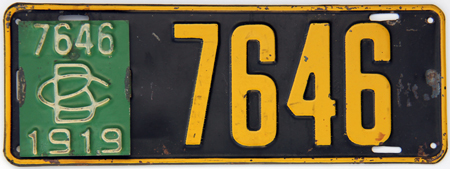 |
| Gallery - 1919 | |||||
One of the great aspects of the 1919 renewal tab is reading the old newspaper stories where motorists get themselves into trouble trying to figure out the new registration system. Take the case of a Vancouver motorist who was charged for driving his truck without proper 1919 plates attached. In his defence, he argued that he had the properly issued 1919 tabs affixed to the front and rear of his truck but that one of the "plates to which the 1919 attachment had been fastened was a home-made affair with a canvas back and aluminum figures." The Chief Constable for the City argued that the motorist was legally required to display a complete license plate issued by the Provincial Police - being the base plate as well as the 1919 renewal tab - and that if one of the base plates was lost he needed to apply for a new set. In response, the motorist pointed out that the Provincial Police were not issuing new base plates for old cars in 1919 and that his truck carried what had been issued, which was the renewal tabs. Before adjoining to consider the matter for a week, the Magistrate announced that "if the Provincial Police do not issue a complete number plate, but only a 1919 attachment, it seems to me they are putting people in [the] wrong, and making it difficult for the municipal police to enforce the law." Further, "I do not wish to penalize you if the Provincial Police are not issuing complete plates for old cars this year ..." It is not known what the final decision of the Magistrate was in this matter. |
One of the challenges in moving to a renewable license plate was determining how many "new" plates would be needed over the course of the second year - being 1919 - for new cars coming into the province needing to be registered for the first time in BC or previously registered cars that had been left off the roads in 1918. Based on available Provincial Police records, it is known that the last new registration issued in 1918 occurred on December 30th and involved the No. 16-341. If current guesstimates are correct, this left approximately 4,159 unused 1918 plates that could continue to be issued into 1919 (e.g. to plate No. 20500). As the Provincial Police tracked vehicle registration trends, they knew that numbers had been increasing significantly since 1914:
If the trend line for new vehicles registered in 1919 remained the same as the previous two years (e.g. 32-34% increase), approximately 5,000 plates would be needed. As the Provincial Police already had around 4,000 plates (to No. 20-500) left over from the last order filled by Tacey & Son in 1918, an additional 1,000 plates (to No. 21-500) should have all that was needed to meet demand for 1919. This is borne out in the historical record as plates numbered between 20-500 and 21-500 have been produced without the 1918 date and square frame stamped into the base - which suggests they were made in 1919: |
 |
This was attributed to the number of new cars coming into the province from the summer onwards being double the rate that had been anticipated by the Provincial Police. To deal with the issue, the province made the decision to order 500 cardboard plates that would be numbered from 21-501 to 22-000 and produced under contract by a printer in the Marpole neighbourhood of Vancouver. It is assumed that this decision was influenced by the availability and cost of materials following the end of the Great War the previous year and a desire not to spend un-necessarily on license plates that would be retired in less than 2 months time (as new base plates had been made for 1920). Otherwise, it is hard to understand such a decision given the likely deleterious impacts of the wet winter weather conditions on the visibility and integrity of the plates in coastal rain forest locations such as Vancouver and Victoria. |
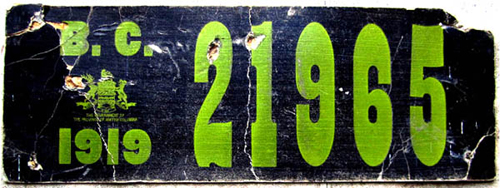 |
The 1919 Cardboard plates are probably the rarest of all BC plates with only one known surviving example, being the plate No. 21965 (shown above). |
The
"Motor Vehicle Receipt" (far left) and "Registration Form" were submitted to BCpl8s.ca
by Tom Bourne, who advises that it was issued to his grandfather,
W. Cox. |
||
| As can be seen on both documents, they are date stamped the 15th of November, 1919, but of even more interest is that the "Motor Licence Number." (which is taken to be the number on the license plate) is shown as 21,722. | ||
| By this time, the supply of regular license plates had been exhausted and that the recipient would have received a temporary cardboard plate to see them through to 1920 and the issuance of a new base plate. |
*
* * * * |
| 1920 | |||||||||||||||||||||||
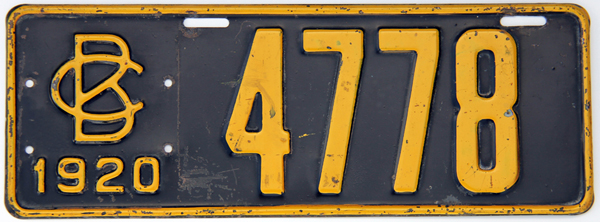 |
|
||||||||||||||||||||||
Although it had been reported that the 1918 license plates would be used for a period of three years through the use of a green renewal tab in 1919 and a red tab in 1920 (see above), a new base plate was made for 1920 with many of the same features as the 1918 base with the exception of the pre-punched slots for the renewal tab. These were replaced on the 1920 base with 4 holes to be used to rivet in-place the planned renewal tabs to be issued in 1921 and 1922 that would use the same colours as had originally been planned for the 1919 and 1920 tabs (e.g. green and red). It is assumed that this was deemed to be an important security improvement warranting the retirement of the 1918 base a year early. The folding wings used to affix the 1919 tabs to the 1918 base had proven easy to remove by thief's and other assorted scofflaws and the new riveted tabs were designed to combat this. |
| Gallery - 1920 | |||
 |
|||
Upon completing the 1920 license plate contract, Tacey announced that his "shop quarters" on Seymour Street were too small to accommodate his expanding business and announced his intention to relocate to 550 6th Avenue West in July of that year. The cost of the factory, which was to house Tacey's sheet metal works and a garage, was estimated at $6,000 and the plans, prepared by Twizell, Birds and Twizell, called for a 50 x 80 foot structure made "of concrete, hollow tile and mill construction". Two additional building permits for work on the building were taken out in 1920 and 1921. |
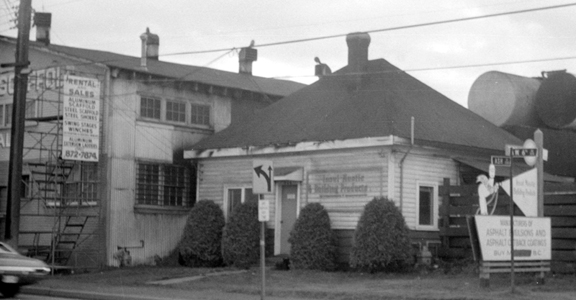 |
| It is thought that the factory constructed by J.R. Tacey & Son in 1920 can be seen to the left of the house in the above photo, which was taken at the intersection of 6th Avenue West and Ash Street in 1974. The sign writing on the side of the factory hints at its use by a Scaffolding Company, and it is assumed that Tacey Sheet Metal Ltd. had ceased operating or was acquired by a competitor after Fred Tacey's death in 1955. |
According to an article in the local press in 1920, it was reported that:
Tacey would win the contract for the 1920 license plate series and included a feature, reputed to be a "patented device" that would allow for the renewal of the plates by a tab in 1921 and 1922. (NOTE: the Canadian Patents Database shows the only patent registered to John Reuben Tacey being a "sun and rain visor for windshields of automobiles in 1923) Due to Tacey's Patent, no tenders were posted in 1921 or 1922 as no other manufacturer of plates was purportedly entitled to use his 1920 base plates, while "34,500 pairs of motor number plate markers" would be purchased from Tacey & Son in 1922 at a cost of $8,500.00. |
*
* * * * |
The renewal tabs produced by Tacey for 1921 displayed the red that had originally been announced for 1920 before the decision was made to produce a whole new base plate for 1920. The colour of the tabs were described in one press account as "brilliant red with the B.C. Coat of Arms [sic] and 1921 in aluminium paint, the number of the license is also carried in miniature, to aid issuance: |
 |
 |
Gone are the folding wings seen on the 1919 tabs and in their place are not two (2) but four (4) bolt holes to be used to securely attach the tabs to the 1920 base! |
| Gallery - 1921 | |||||
A challenge with the renewal tab system was that car owners were "to have their old numbers, under this system, [and this] caused immense work in sorting the correct numbers for shipment to the various districts in B.C., and often it was found that several of the cars had been removed to another part of the province and their numbers had to be despatched again." A case in point being that of Angus Shaw of Victoria:
"Call and get your license early" was the urgent request of the Provincial Police, however, had a new base plate been issued for 1921 instead of tabs, a lot of this work could have been avoided, save for those motorists with "reserved" numbers, which were generally between 1-8,000. |
It was much easier to forge a small tag instead of a full sized plate when undertaking illicit activities. While we here at BCpl8s.ca have never seen one of these counterfeit blue renewal tabs used in the early 1920s, we would certainly be interested in a photo if anyone has something fitting this description in their collection. |
*
* * * * |
| 1922 | |||||||||||||||||||||||
|
|||||||||||||||||||||||
| Gallery - 1922 | |||||
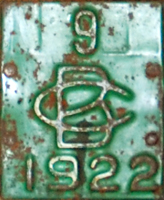 |
|||||
What makes the 1921 plate with matching tab one of
the hardest BC's to obtain is the use of a similar tab in 1922. As a result, when many motorists obtained their 1922 tabs, they simply discarded the '21 tabs. It is important, therefore, to look for a tab
that matches the number on the 1920 base plate, such as
the ones pictured above. |
 |
It is also important to look for a tab
that matches the number on the 1920 base plate, or if the numbers do match, to ensure that the base is an actual 1920 (and not the very similar looking 1918). |
 |
J.R. Tacey & Son is also known to have branched out into using their equipment to make booster plates for tourist associations and local businesses. |
There are numerous examples of people who, when states and provinces first started requiring license plates collected every single one issued to them over the decades. More difficult is identifying the person who took that next big step and started collecting plates that were never issued to them and from other states and provinces in North America. A great story in the April 2017 issue of "Plates" (the bi-month magazine of ALCPA) attempted to answer this, or at least set a base line for who might be the "first" license plate collector; Charles Benedict Brooks of Pearl Creek, NY, who appears to have started collecting in 1916 by writing to various motor vehicle departments requesting plates. It would not be until late 1922 that Charles would being to write to various Canadian provinces seeking plates for his collection. In response to his query, the BC provincial police would send him an example of a 1922 (i.e. 1920 base with matching 1922 tab) - the No. 25170. When Brooks' collection was auctioned in 2015, the BC went for the fifth highest price. |
*
* * * * |
| 1923 | |||||||||||||||||||||||||
 |
|
||||||||||||||||||||||||
For this reason, the Vancouver Automobile Club began to lobby the provincial government in 1922 to replace the "BC" acronym that had been in use informally since 1904 and formally since 1913 with the words "British Columbia" on the 1923 license plates. This request was not granted in time for the 1923 plates, but a temporary compromise appears to have been settled as the intricate and intertwined BC design used since 1918 was untangled and replaced with a simpler, more easily readable version. "BRITISH COLUMBIA" would appear the following year (1924) and, to read more about this, see the next section on the 1924-1929 plates. |
Apart from the change to the BC acronym, the basic design of the 1923 plate would differ little from the 1920 base with the only real differences being the absence of slot holes for renewal tabs. Otherwise, the shape of the plate remained the same as did the dies used in 1918 & 1920, while the yellow paint from the 1918 and 1920 bases appears to have been used again. |
It is likely this was attributable to the extra work that issuing tabs that had to match the base plates had caused the Provincial Police and a desire to reduce this burden. Starting in 1923, motorists would no longer receive the same number they had the previous year - with the exception of the "reserved list" - and, instead, would be handed the next number in the rotation. As it was described in the local press:
This change can be seen in the Registers maintained by the Provincial Police and how numbers had been recorded between 1904-1922 versus 1923: |
 |
In this instance, the No. 17333 was issued to a motorist in New Westminster in 1919, and they were able to renew the same number in 1920. The challenges of this system for the Provincial Police are evident by the numbers issued on either side of 17333; the No. 17332 was issued to someone in Sardis (Chilliwack) and the No. 17334 was issued to someone in Langley Prairie. As vehicle numbers in the province continued to expand exponentially, maintaining such a system became less and less feasible. Under the changes implemented for 1923, New Westminster office of the Provincial Police were issued a block of passenger license plates numbered between 15,501 and 19,500 (shown above-left) and motorists registering at this office would only be given a number from this allotment - regardless of what their number had been in 1922. |
To explore these changes, see our page on the Archival Records of the Motor Vehicle Branch. |
| Gallery - 1923 | |||
 |
|||
 |
 |
||
 |
|||
It was reported that New Westminster received 2.5 tons of 1923 license plates on November 28, 1922, in the form of 4,000 license plates numbered between 15-501 and 19-500, each weighing 20 ounce each for a total of 5,000 pounds. Issuance was scheduled for the last week of December 1922. In Vancouver, plates numbered 19-501 to 35-000 were received and motorists were advised that, first time in two years, they would not be receiving the same license plate number as they had the previous year when "small metal squares" had been issued. |
1923 would also mark the start of mild political jousting in the Legislature over the awarding of the annual license plate contract to J.R. Tacey & Son. Robert Pooley, Conservative Member for Esquimalt and a future Attorney General criticized Alexander Manson, Liberal Member for Omineca and Attorney General for awarding the contract to a firm that was not the lowest. Attorney General Manson subsequently advised that the lower tenders had been received from companies based outside of the province - and the government's notices tended to state that "plates manufactured in British Columbia will be given preference" - and that bids for the license plate contract had been received from the following: |
|
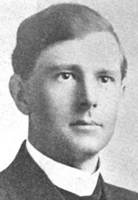 Alexander Manson |
 Robert Pooley |
The contract would, again, be awarded to J.R. Tacey & Son, who would, according to Manson, produce 41,300 pairs of license plates and "2,600 single motor number-plates". |
The Motor Office would subsequently become the head office of the Motor Vehicle Branch (MVB) and operated, it is thought, at this location into the 1990s when the MVB was subsequently rolled into ICBC. The picture at left was taken in 1971 and the MVB's name is visible on the canopy at front. |
Quick Links: |
Antique | APEC | BC Parks | Chauffeur Badges | Collector | Commercial Truck | Consul | Dealer | Decals | Driver's Licences | Farm | Ham Radio | Industrial Vehicle | Keytags | Lieutenant Governor | Logging | Manufacturer | Medical Doctor | Memorial Cross | Motive Fuel | Motor Carrier | Motorcycle | Movie Props | Municipal | National Defence | Off-Road Vehicle | Olympics | Passenger | Personalized | Prorated | Prototype | Public Works | Reciprocity | Repairer | Restricted | Sample | Special Agreement | Temporary Permits | Trailer | Transporter | Veteran | Miscellaneous |
© Copyright Christopher John Garrish. All rights reserved.



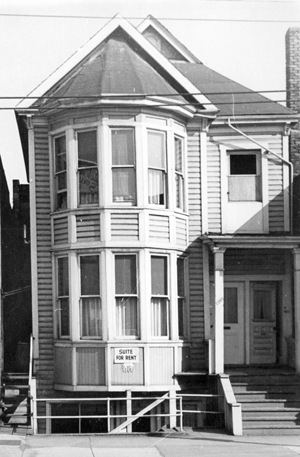

 While the election occurred too late in the year to influence the awarding of the 1917 license plate contract, the Brewster government would subsequently award the 1918 contract to Tacey despite his not having any expertise in this area, unlike the MacDonald Manufacturing Company with their history of printing advertising copy on tin products.
While the election occurred too late in the year to influence the awarding of the 1917 license plate contract, the Brewster government would subsequently award the 1918 contract to Tacey despite his not having any expertise in this area, unlike the MacDonald Manufacturing Company with their history of printing advertising copy on tin products.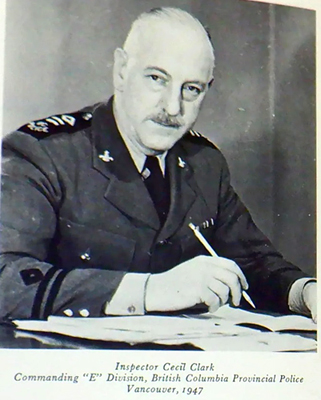 According to Cecil Clark (1899-1993), it was by reaching out to a company in Washington State - thought to be the Pacific Coast Stamp Works of Seattle who had previously bid on the contract for making BC plates (e.g. 1915) - that was already making license plates for that state and striking a deal to buy some of their equipment at a cost of $7,000 and receive training in how to make plates.
According to Cecil Clark (1899-1993), it was by reaching out to a company in Washington State - thought to be the Pacific Coast Stamp Works of Seattle who had previously bid on the contract for making BC plates (e.g. 1915) - that was already making license plates for that state and striking a deal to buy some of their equipment at a cost of $7,000 and receive training in how to make plates. 
 Thanks to a profile of Tacey's new license plate production facility that was published by the Vancouver Sun in early 1918, we have a pretty good understanding of the machinery Tacey acquired from the Americans and how it worked.
Thanks to a profile of Tacey's new license plate production facility that was published by the Vancouver Sun in early 1918, we have a pretty good understanding of the machinery Tacey acquired from the Americans and how it worked.


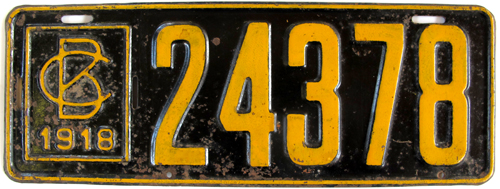
 On December 29, 1918, motorists were reminded that 1919 license plates could be acquired from the provincial police and were to be affixed to the 1918 plates before the end of the registration year.
On December 29, 1918, motorists were reminded that 1919 license plates could be acquired from the provincial police and were to be affixed to the 1918 plates before the end of the registration year.


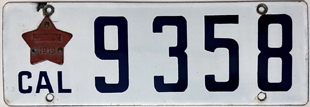
 It is interesting that local press account from the time indicate that Tacey was exploring the use of a "disc" to renew license plates in 1919 and 1920 as a stroll through the US Patent Database (thanks Google!) for "renewable license plate" inventions registered between 1910 to 1920 reveals a "disc" proposal illustrated on a Washington plate dated 1920.
It is interesting that local press account from the time indicate that Tacey was exploring the use of a "disc" to renew license plates in 1919 and 1920 as a stroll through the US Patent Database (thanks Google!) for "renewable license plate" inventions registered between 1910 to 1920 reveals a "disc" proposal illustrated on a Washington plate dated 1920.




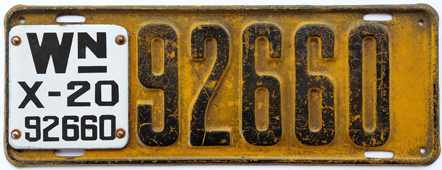
.jpg)

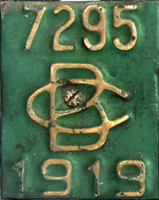


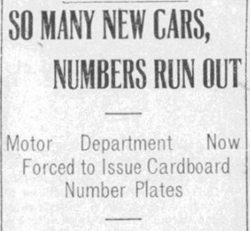 As it happens, the Provincial Police misjudged the number of vehicle registrations that would occur in 1919 and by early November of that year they had issued all 21,500 of their available bases.
As it happens, the Provincial Police misjudged the number of vehicle registrations that would occur in 1919 and by early November of that year they had issued all 21,500 of their available bases.
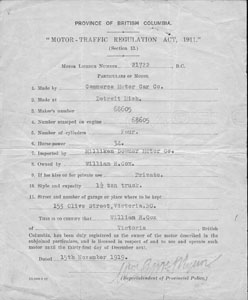
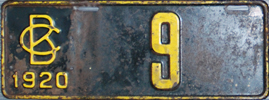


 The larger work space, which was completed by the end of September of 1920, would allow Tacey to install new plate making machinery such as "an electric oven for enamelling the embossed license plates" that would have a capacity of 200 cubic feet and "be the largest of its kind in Canada."
The larger work space, which was completed by the end of September of 1920, would allow Tacey to install new plate making machinery such as "an electric oven for enamelling the embossed license plates" that would have a capacity of 200 cubic feet and "be the largest of its kind in Canada." 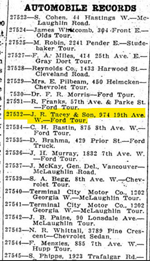



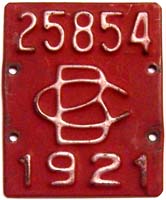










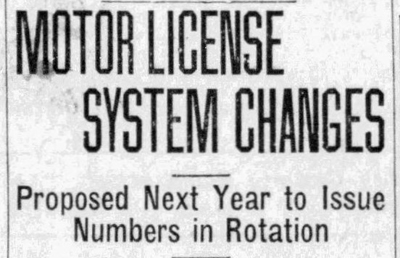











 On December 15, 1923, the Provincial Police announced that they had relocated their "Motor Office" from the Old Court House on Bastion Street to the Old Drill Hall at 421 Menzies Street in Victoria.
On December 15, 1923, the Provincial Police announced that they had relocated their "Motor Office" from the Old Court House on Bastion Street to the Old Drill Hall at 421 Menzies Street in Victoria.